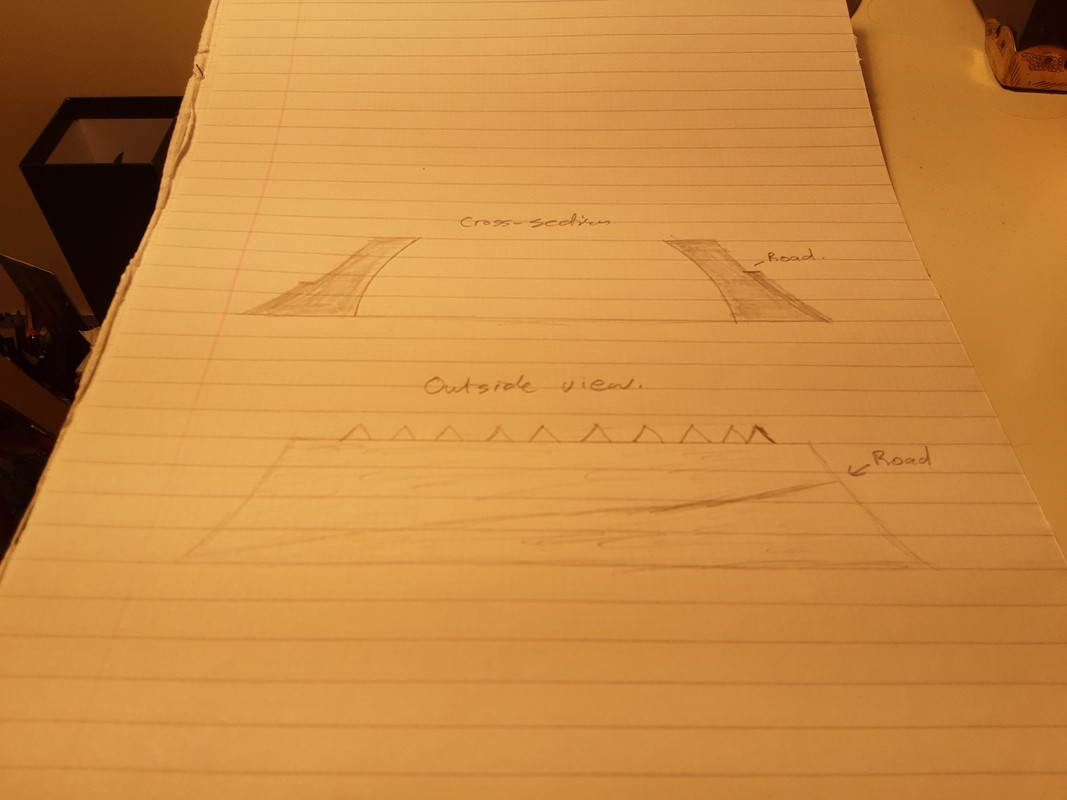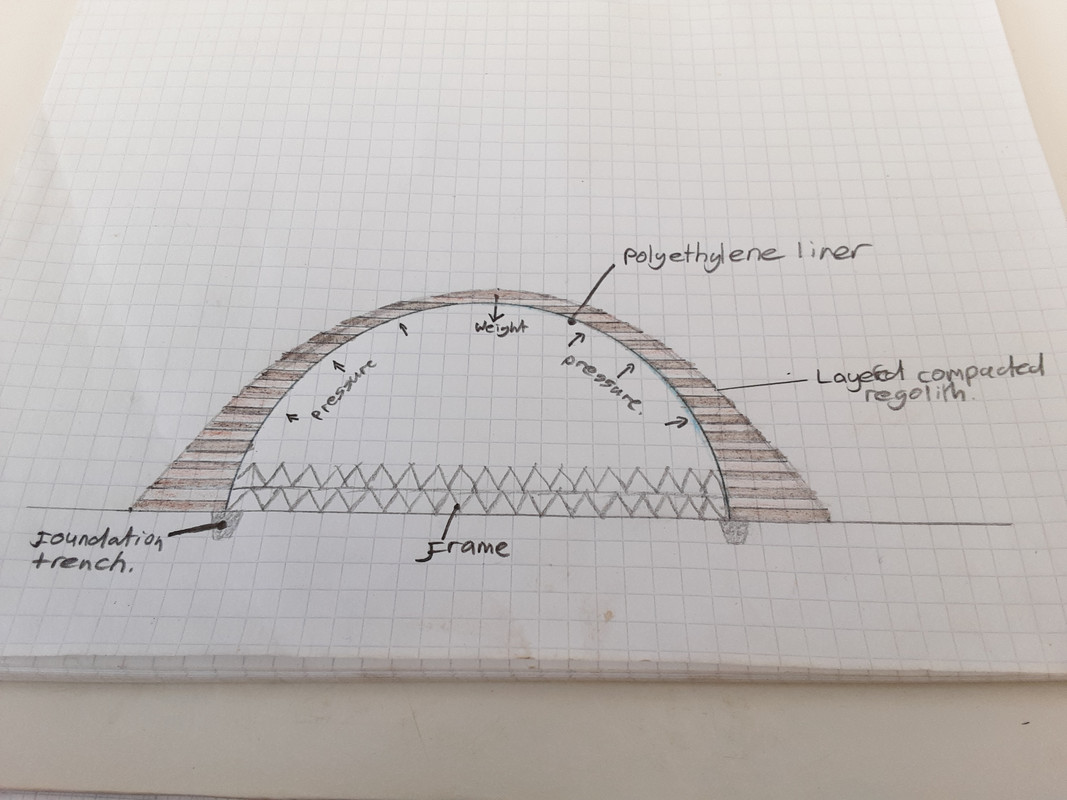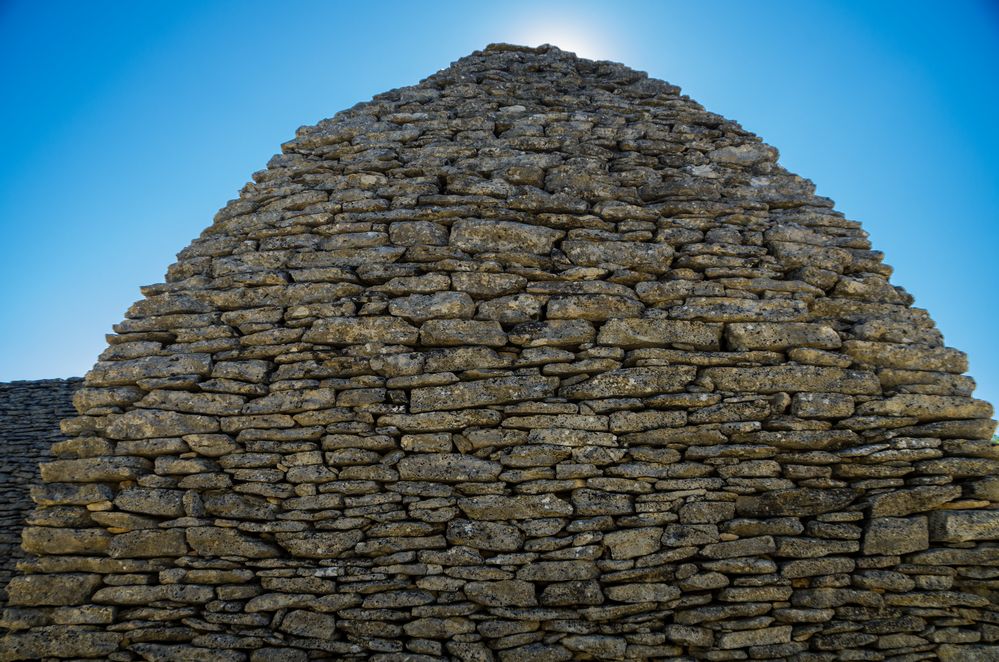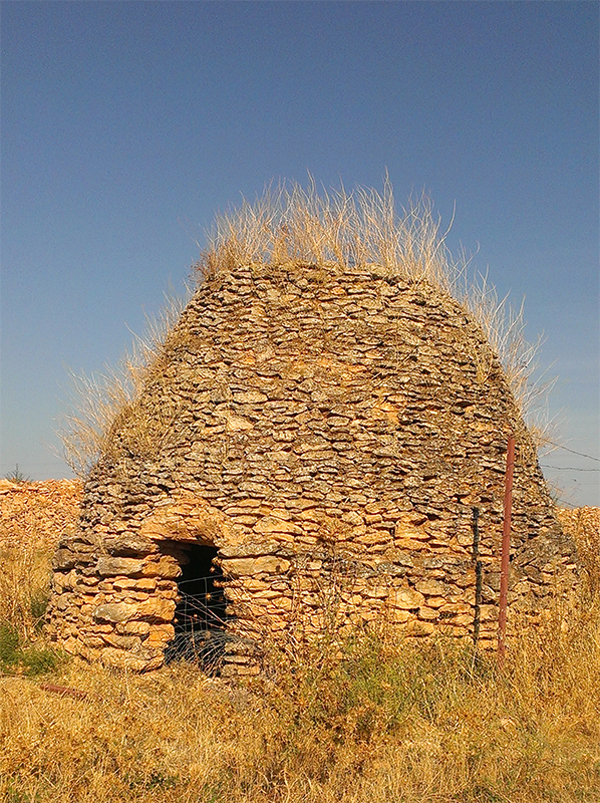New Mars Forums
You are not logged in.
- Topics: Active | Unanswered
Announcement
#1 2024-05-19 17:28:44
- Calliban
- Member
- From: Northern England, UK
- Registered: 2019-08-18
- Posts: 3,967
Buried geodesic domes
This website provides an excellent rendering of a geodesic dome.
https://www.renderhub.com/ocstard/geodesic-dome-1
The dome is constructed entirely from a single length member. However, notice that some of the cells in the dome are pentagons rather than hexagons. This tells us that the angle between members is not perfectly constant. So building such a dome requires careful planning when bolting structural members together.
Domes provide an easy way of building compressive structures on Mars. The frame can be made from cast iron, steel or cast basalt. Some kind of keying is required to position the ends of each member, such that angles are correct. But frames can be built up and covered in strips of tarp or polythene as each new layer is added. Regolith berms can be heaped up progressively, as the height of the frame increases. This allows robots and humans a flat surface to work on as each new row of cells is added. Climbing up the dome is therefore simple, as a dirt track can spiral up the regolith berm, allowing vehicles to drive up the berms during construction.
When complete, the dome is covered in several metres of graded regolith and is pressurised. The pressure inside is balanced by the weight of the regolith. Prior to pressurisation, the dome frame provides a shape former for the self supporting, compacted regolith shell. Truly huge volumes can be enclosed in this way, as the regolith berm can be tapered towards the bottom. To balance an internal pressure of 0.5 bar, the minimum thickness of compacted regolith covering the frame must be about 6.5m on Mars. The regolith berm would get thicker as one heads toward the base. At all points in the berm, the net resultant vector of the inner force of air pressure and weight of the overbearing regolith, must not bend outside of the berm surface. We are relying on the weight of the regolith overburden to prevent the berm from exploding due to air pressure within.
Halfway through construction, the dome would look something like this:
Last edited by Calliban (2024-05-19 18:03:06)
"Plan and prepare for every possibility, and you will never act. It is nobler to have courage as we stumble into half the things we fear than to analyse every possible obstacle and begin nothing. Great things are achieved by embracing great dangers."
Offline
Like button can go here
#2 2024-05-19 17:50:58
- tahanson43206
- Moderator
- Registered: 2018-04-27
- Posts: 20,797
Re: Buried geodesic domes
This post is reserved for an index to posts that may be created by NewMars members over time.
This topic ** should ** hain a following!
The admins are working on a new "Like" feature.
This topic seems destined for several "likes".
(th)
Offline
Like button can go here
#3 2024-05-19 18:04:18
- SpaceNut
- Administrator
- From: New Hampshire
- Registered: 2004-07-22
- Posts: 29,457
Re: Buried geodesic domes
We also would not want a drop of internal pressure to cause an implosion as well.
Sounds like a concrete product from mars with rebar made with basalt materials within to form the panels that drop within the framing.
Such a building would have a multi chamber air lock to balance transition from inside to out with cleaning within the chamber.
Offline
Like button can go here
#4 2024-05-19 18:20:07
- Calliban
- Member
- From: Northern England, UK
- Registered: 2019-08-18
- Posts: 3,967
Re: Buried geodesic domes
We also would not want a drop of internal pressure to cause an implosion as well.
Sounds like a concrete product from mars with rebar made with basalt materials within to form the panels that drop within the framing.Such a building would have a multi chamber air lock to balance transition from inside to out with cleaning within the chamber.
Martian regolith is quite sticky. When compacted, the grains tend to lock together. So in the event of depressurisation, the berm should remain intact. The tarp or polythene sheets wrapped around the frame should prevent any loose scabs of material from dropping into the void. We are relying upon the compressive strength of the regolith berm to hold itself up during construction. To prevent it from crumbling under compressive stress, it is tapered towards the base.
One problem that this concept does raise is the need to gather and move a lot of regolith to build up the berm. For a dome that is 200m in diameter, we would need to shift something like 2 million tonnes of dirt to cover it. This is stuff that we can just scoop up of the surface. But 2 million tonnes is a lot. Probably the easier option would be to use conveyor belts to carry dirt up the spiral road around the berm. If the conveyors can move 100kg/second, then it would take about 8 months to build up the soil berm for a 200m diameter dome.
Last edited by Calliban (2024-05-19 18:46:33)
"Plan and prepare for every possibility, and you will never act. It is nobler to have courage as we stumble into half the things we fear than to analyse every possible obstacle and begin nothing. Great things are achieved by embracing great dangers."
Offline
Like button can go here
#5 2024-05-19 18:47:17
- SpaceNut
- Administrator
- From: New Hampshire
- Registered: 2004-07-22
- Posts: 29,457
Re: Buried geodesic domes
We do have topics with the compressed brick such as this one No bake Mars bricks
The soil used is still affected by moisture and it will smell as it does react. Coating the bricks individually exposed to the habitat is the only way to do this.
Offline
Like button can go here
#6 2024-05-25 15:47:44
- Calliban
- Member
- From: Northern England, UK
- Registered: 2019-08-18
- Posts: 3,967
Re: Buried geodesic domes
This article confirms that fine Martian regolith forms a geopolymer under compression. That is to say, it forms a hard brick-like material.
https://en.m.wikipedia.org/wiki/Martian … h_simulant
It should therefore be possible to build up rammed soil berms around a dome. These will provide level surfaces to work on as the dome is constructed and will counterbalance internal air pressure when the dome is pressurised. The geopolymer properties mean that the dome itself needs only function as a shape former. The shell of compressed regolith will support its own weight due to the compressive polymerisation. We would wrap each new layer of the dome with polyethylene or covering panels before building up a new layer of graded soil. When completed, the dome frame and polythene will remain in place to prevent loose material from falling into the space.
As the berm will be tapered, it should be possible to build enormous pressurised volumes in this way. Multiple domes can also be connected via tunnels. Domes hundreds of metres in diameter could be painted blue on the inside to simulate sky. Domes of this size could have buildings constructed within them. In this way, we can build up comfortable subsurface cities.
The dome structure will be made from repeatable units, probably cast basalt. Some kind of keying arrangement is needed to allow the edges to meet at precisely the correct angle. Given the high strength of cast basalt, epoxy glue could be used to connect the elements within a keying jig, which is reused. As we will be applying mass production to bring costs down, it would be sensible to decide upon a standard dome diameter. We can then cast millions of basalt members in reusable sand moulds.
Last edited by Calliban (2024-05-25 15:59:22)
"Plan and prepare for every possibility, and you will never act. It is nobler to have courage as we stumble into half the things we fear than to analyse every possible obstacle and begin nothing. Great things are achieved by embracing great dangers."
Offline
Like button can go here
#7 2024-05-25 17:53:26
- tahanson43206
- Moderator
- Registered: 2018-04-27
- Posts: 20,797
Re: Buried geodesic domes
for Calliban re #6...
Will the bricks be sealed with some kind of mortar?
If they are going to be under pressure (as seems reasonable) mortar of some kind between the bricks might make sense.
I note the recommendation to separate layers with polyethylene, but wonder if mortar might be a good idea to increase the strength of the dome?
(th)
Offline
Like button can go here
#8 2024-05-25 20:25:14
- Void
- Member
- Registered: 2011-12-29
- Posts: 8,206
Re: Buried geodesic domes
I may inquire if you could consider a Quonset hut shape as an alternative to a dome. (But modifying the ends to be rounded half domes).
https://en.wikipedia.org/wiki/Quonset_hut
Image Quote: 
Then to connect this like sausage links. With appropriate tunnels and doors between sections.
https://frankandsal.com/collections/fre … ith-fennel Image quote: 
In a spiral if you desire or a linear or gridiron pattern or hexagonal if you may like.
Circular running rings might be good for health.
Done
Last edited by Void (2024-05-25 20:33:19)
End ![]()
Offline
Like button can go here
#9 2024-05-27 08:16:32
- Calliban
- Member
- From: Northern England, UK
- Registered: 2019-08-18
- Posts: 3,967
Re: Buried geodesic domes
There are no bricks. The loose regolith will be built up in layers around the dome and then compacted by running heavy equipment over it. See below.
The polyethylene liner would be wrapped around the frame from polyethylene rolls before each new layer of regolith is laid down.
Last edited by Calliban (2024-05-27 08:29:38)
"Plan and prepare for every possibility, and you will never act. It is nobler to have courage as we stumble into half the things we fear than to analyse every possible obstacle and begin nothing. Great things are achieved by embracing great dangers."
Offline
Like button can go here
#10 2024-05-27 08:33:00
- SpaceNut
- Administrator
- From: New Hampshire
- Registered: 2004-07-22
- Posts: 29,457
Re: Buried geodesic domes
I am wondering if the bricks or compacted materials nearest to the internal volume where mixed with a binder before laying the material down with a 3d printer followed by insulation and then with the compacted outside layer.
Your drawing making the layers start out thicker to thinner as it reaches the top of the dome makes sense for the pressure inside.
Offline
Like button can go here
#11 2024-05-27 11:07:29
- Calliban
- Member
- From: Northern England, UK
- Registered: 2019-08-18
- Posts: 3,967
Re: Buried geodesic domes
We could use a layer of compressed soil bricks around the frame.
https://en.m.wikipedia.org/wiki/Compressed_earth_block
Mars soil is rich in sulphur and iron oxide, so compression alone will produce strong bricks. No binder needed, as iron oxide grains will bind under pressure. Graded fines will act as a mortar between the blocks. For this to work, the regolith that goes into the brick press needs to be sieved to omit particles coarser than about 0.1mm, as the strength of the brick will depend upon bonding between particles.
The inner brick surface can be painted after the dome is finished and pressurised. Any vegetable based oil could be used as a paint binder. It will polymerise in air and form a hard surface. Walnut and linseed are often used to produce polished earthern floors in much the same way.
"Plan and prepare for every possibility, and you will never act. It is nobler to have courage as we stumble into half the things we fear than to analyse every possible obstacle and begin nothing. Great things are achieved by embracing great dangers."
Offline
Like button can go here
#12 2024-05-27 11:29:24
- Calliban
- Member
- From: Northern England, UK
- Registered: 2019-08-18
- Posts: 3,967
Re: Buried geodesic domes
Void, re qounset hut shape. I think this could definitely work as we can fabricate the semicircular beams on the ground and then pull them into a vertical position using a sling. Cross-braces can then be used to attach it to the neighbouring beam.
The traditional hut was covered with a skin of corrugated iron, which was rivetted to the frame. If we can do the same on Mars, then regolith can be piled over the top to balance internal pressure. We could do away with the corrugated iron and instead use compressed soil blocks to bridge the gap between the beams.
Last edited by Calliban (2024-05-27 11:32:23)
"Plan and prepare for every possibility, and you will never act. It is nobler to have courage as we stumble into half the things we fear than to analyse every possible obstacle and begin nothing. Great things are achieved by embracing great dangers."
Offline
Like button can go here
#13 2024-05-27 14:50:21
- SpaceNut
- Administrator
- From: New Hampshire
- Registered: 2004-07-22
- Posts: 29,457
Re: Buried geodesic domes
It looks like we need particular dimensions for this to be considered for building and use.
Things like top of the dome to be ALON so as to make use of natural lighting, Number of floors for the crew that could occupy such a place.
Amount of internal area for gardens and other such support that makes this part of a settlement.
Offline
Like button can go here
#14 2024-08-12 12:47:32
- Calliban
- Member
- From: Northern England, UK
- Registered: 2019-08-18
- Posts: 3,967
Re: Buried geodesic domes
This image shows a dry stone rock dome.
Another here.
These are examples of habitable volumes that are created using nothing more than sorted loose rocks. Structures like this could be built on Mars and covered with about 5 metres of regolith. This would balance internal pressure and provide insulation against the cold.
Last edited by Calliban (2024-08-12 12:57:56)
"Plan and prepare for every possibility, and you will never act. It is nobler to have courage as we stumble into half the things we fear than to analyse every possible obstacle and begin nothing. Great things are achieved by embracing great dangers."
Offline
Like button can go here